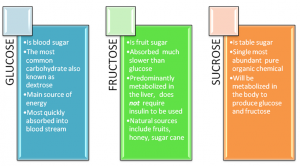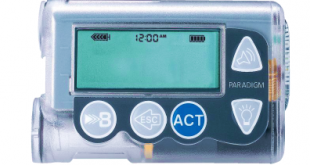Is Fruit A Sugar?
Yes, the main component in fruits is carbohydrate or also known as sugar. Almost all of the calories from fruit are derived from sucrose, which is a simple carbohydrate or simple sugar. Fruit, as any other carbohydrate may raise blood glucose if taken in excess.
Carbohydrate (link: Eating Healthy for Diabetes) provides most of the energy needed by our body. It can be grouped into two types upon their chemical structure. Yet, many people are still confused about the differences between simple and complex carbohydrate.
Is Sugar From Fruits Safe for Diabetics?
Yes, fruit sugar is safe for diabetics. However, they are still carbohydrate that produces calories that has to be counted into daily requirement of people with diabetes. Sugar can be classified into two groups that is simple carbohydrate and complex carbohydrate. The figure below shows three examples of simple carbohydrate / simple sugar that we always come across in our diet.
Sugar from fruits comes under simple carbohydrate as in the above figure. It is absorbed into our blood stream much slower than glucose. Fructose also does not require insulin for the metabolism because predominantly, it is metabolized in the liver compared to glucose and sucrose.
Can People With Diabetes Eat Fruits?
In discussing about healthy diet, it is a fact that our body needs all the essential nutrients in sufficient amounts. This is true in the diabetic diets too! Fruit is healthy for everyone, including people with diabetes. Experts suggest that most people with diabetes can — and should — include fresh fruit in their daily diet. Fruit gives you energy, vitamins, minerals and fibre. Fibre helps to delay sugar absorption, increase satiety level, reducing cholesterol and help to reduce constipation. When people eat enough fruits, they have less chance of having a stroke or getting heart disease especially for people with type 2 diabetes.
It is true that different types of carbohydrates can affect your blood sugar level differently. It is common to think sugar in fruit will raise our blood sugar too fast or too high. However, experts suggest to pay more attention on the total amount of carbohydrate for people with diabetes. This is because, total carbohydrate intake has more effect on blood sugar than the type. Even though fruit contains natural sugars, most varieties hold a low glycaemic index (read : Glycaemic Index & Glycaemic Load) due to their fructose and fibre content, most fruit is easily portable, making it a terrific on-the-go snack.
Nutrient in Fruits
As the interest in nutrition increases, more information on fruits and its content grows. Fruit is hundred percent natural and rich in nutrients which would benefit us. Here are some example of important nutrients and their functions that we can obtain from fruits.
| Nutrients | Functions | Fruits |
| Vitamin A | Essential for healthy eyes and clear vision, assists in the growth of skin and mucous membranes and also strengthens the body’s immune system. | Oranges, mangoes, papayas, jackfruits, apricots, red or pink grapefruits |
| Vitamin C | Essential for the development and maintenance of connective tissue, speeds the production of new cells in wound healing and also as an antioxidant, helps protect the immune system. | Guavas, oranges, kiwis, strawberries, papayas, dragon fruits, grapefruits, tangerines |
| Folic Acid | Helps in production of red blood cells, the reduction of blood homocysteine levels, cell growth and division, protein metabolism and prevention of neural tube defects and anencephaly. | Oranges, papayas, bananas |
| Potassium | Stabilizes blood pressure, necessary for muscle function | Bananas, dried fruits, oranges, honeydew melons |
| Fibre | Insoluble fibre found in fruits helps to move foods through the stomach and intestine, thereby decreasing the risk of cancers of the colon and rectum. | Berries (most types), dried plums (prunes), apricots and figs, pears |
How Much Fruit Do I Need A Day?
Fruit is a carbohydrate that has to be counted in a daily meal of people with diabetes. The Malaysian Dietary Guidelines 2010 strongly advised fruit to be taken 2 – 3 servings per day at one serving (read : Diabetic Meal Plan) per meal. You can talk to your dietitian about the amount, frequency and types of fruit you should eat.
Tips Eating Fruit for Diabetic
Many people wanted to know about which fruit that do not raise the blood sugar immediately. Here are some tips in choosing fruit which would benefit people with diabetes :
a) High Fibre Content
Fruits which are rich in fibre have a lower glycaemic index. Examples are citrus fruits (oranges), rose apple, guava, pear, peaches and apples. They are rich in soluble fibre, less likely to cause spikes in the blood sugar of people with diabetes. The fibres in these fruits slow down the absorption rate of sugar in the bloodstream.
b) Low Glycaemic Index (GI)
Most fruits have a low glycaemic index because of their fructose and fibre content. These fruit groups are better choices for people with diabetes. Glycemic Index is an indicator to describe the effect of carbohydrates present in food on our blood glucose levels. General rule is, low GI fruits will produce small change in our blood glucose and levels of insulin. These fruits release the glucose slowly into the blood. As a result, it avoid sudden rise in blood glucose levels. This is an important factor in diabetes management.
| GI Categories | Recommendation | Examples |
Low GI Fruits(GI value < 55)
|
Good choices for keeping your blood sugar levels under control. | Cherries, guavas, rose apples, apples, pears, peaches, grapefruits, plums, grapes, kiwifruits, oranges, strawberries and prunes |
Medium GI Fruits(GI value 56 – 69
|
Consume in moderation, even though this group do not produce a sharp rise in blood sugar, there will still be an influence over your blood sugar levels. | Mangoes, bananas, raisins, papayas, figs and pineapples |
High GI Fruits(GI value > 70)
|
Limit or eat together with high fibre diets. Eating these fruits, especially in large quantities, can cause your blood sugar levels to rise quickly. | Watermelon, dates |
c) Enjoy Variety Of Fruits
Enjoy various types of fruits for their wonderful flavour as well as for good nutrition. Different coloured fruits and vegetables contain different minerals, nutrients and antioxidants. Therefore, eat a wide variety of fruits to get all the nutrients you need: an orange at lunch and a guava during dinner.
d) Choose Whole Fruits
The Dietary Guidelines suggests eating whole fruits compared to fruit juices as the most intact collection of nutrients comes to you through the whole fruit. The edible fruit skin and pulp is rich in nutrients and soluble fibres. Avoid canned fruits, frozen fruits or fruit that has been processed which normally contain much sugar, preservatives or other chemical additives are not desired. Therefore, eating whole, fresh fruits preserves the benefit of nutrients and fibres but in juices, it is reduced.
e) Best Time To Eat Fruit
The best time to eat fruits is in the morning with an empty stomach. This is a gentle way to restart metabolic rate of digestive system after few hours of fasting. Choose low GI whole fruit, it helps to increase blood sugar slowly. Eating fruits before other meals is also a good tip for people with diabetes who wants to lose weight because it helps the stomach to feel full faster. Anyway, it is not advisable for people having gastritis or ulcer to eat fruits with empty stomach, as certain fruits may increase stomach acid. If you work out or play sports regularly, time your fruit consumption for a short while before exercise
References
- Aglaae, J (2011, Feb 11). The Glycaemic Index Table of Fruits & Vegetables. Posted to http://www.livestrong.com/
- American Diabetes Association (2012). Diabetes Myth. Retrieved September 21, 2012, from http://www.diabetes.org/diabetes-basics/diabetes-myths/
- American Diabetes Association: Fruit (http://www.diabetes.org/food-and-fitness/food/what-can-i-eat/fruits.html)
- Azza, P. (2007). Diet and Nutrition: A guide to weight maintenance and healthy living with a Malaysian touch. Kumpulan Karangkraf Sdn. Bhd.
- Buzzle (2012). Fruits for Diabetics. Retrieved September 21, 2012, from http://www.buzzle.com/articles/fruits-for-diabetics.html
- Best 15 Fruits for diabetics. Admin (2011, Nov 18). Posted to http://diabetes.ygoy.com/
- Brian, C. (2012). Simple Sugar VS Complex Carbs. Retrieved September 21, 2012, from http://www.briancalkins.com/simplevscomplexcarb.htm
- Diabetes Digest (2012). Don’t Skip Fruit. Retrieved September 21,2012, from http://www.diabetesdigest.com/article/Don’t-Skip-Fruit/184
- Kathryn G (2011, Apr 11). What Simple Foods Should A Diabetic Be Eating? Message posted to http://www.livestrong.com.
| Last reviewed | : | 03 December 2013 |
| Writer | : | Pn. Hjh. Salha binti Mohamed Nor |
| Accreditor | : | Pn. Viola Michael |
 PENDIDIKAN PESAKIT Kementerian Kesihatan Malaysia
PENDIDIKAN PESAKIT Kementerian Kesihatan Malaysia





